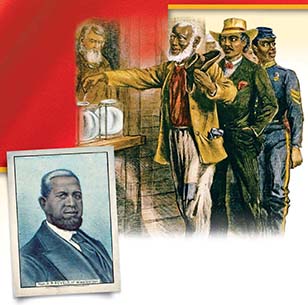SECTION 2: Reconstruction in the South

▲ Freedmen line up to vote.
◄ Portrait of Senator Hiram Revels
WITNESS HISTORY  AUDIO
AUDIO
An African American in the Senate
In 1861, Jefferson Davis left his seat in the U.S. Senate and became President of the Confederacy. In 1870, his unfinished term was resumed by Hiram Revels—an African American. A few months later, Senator Revels stood up to make his first speech. He answered those who charged that African Americans in the South were using their new political power to seek revenge on white southerners:
“As the recognized representative of my downtrodden people, I deny the charge…. They bear toward their former masters no revengeful thoughts, no hatreds, no animosities. They aim not to elevate themselves by sacrificing one single interest of their white fellow-citizens. They ask but the rights which are theirs by God’s universal law…. [to] enjoy the liberties of citizenship on the same footing with their white neighbors and friends.”
—Hiram Revels, speech in the U.S. Senate, March 16, 1870
Objectives
- Explain how Republicans gained control of southern state governments.
- Discuss how freedmen adjusted to freedom and the South’s new economic system.
- Summarize efforts to limit African Americans’ rights and the federal government’s response.
Terms and People
- scalawag
- carpetbagger
- segregation
- integration
- sharecropping
- share-tenancy
- tenant farming
- Ku Klux Klan
- Enforcement Acts
NoteTaking
Reading Skill: Identify Main Ideas Use a chart like the one below to record details about changes in the South during Reconstruction.

Why It Matters Before the Civil War, a limited number of powerful men had controlled the South. In the wake of the war, a very basic question needed to be resolved. Who would gain power and how would they use it? How this question was answered at the time would have both immediate and lasting consequences. Section Focus Question: What were the immediate effects of Reconstruction?
Republican Governments Bring Change
By 1870, all of the former Confederate states had met the requirements under Radical Reconstruction and rejoined the Union. Republicans dominated their newly established state governments.
African Americans Use Political Power
Almost 1,500 black men—some born free, some recently released from slavery—helped usher the Republican Party into the South. These new black citizens served the South as school superintendents, sheriffs, mayors, coroners, police chiefs, and representatives in state legislatures. Six served as lieutenant governors. Two state legislatures—in Mississippi and South Carolina—had black Speakers of the House. Between 1870 and 1877, two African American senators and fourteen African American congressmen served in the United States Congress.
Most importantly, millions of southern African American men were now voters. Since the Radical Republicans required a loyalty oath, many white southerners were not eligible to vote, or chose to stay




